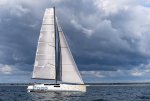Aquaboy
Well-known member
Is there, how shall I say 'rule of thump' as to the angle spreaders should be swept back when you have no back stay?
It's not a performance boat and the rig tension is low so mast bending is not part of the equation.
It's not a performance boat and the rig tension is low so mast bending is not part of the equation.


